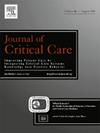The effects of hypnosis and music intervention on comfort and anxiety during weaning from mechanical ventilation: A pilot study
IF 2.9
3区 医学
Q2 CRITICAL CARE MEDICINE
引用次数: 0
Abstract
Objective
To compare the efficacy of hypnosis or music intervention in alleviating distressing symptoms in critically ill patients facing extended or challenging liberation from mechanical ventilation (MV).
Study design
Single-center, prospective interventional trial.
Methods
Critically ill patients experiencing extended or challenging MV weaning were assigned to either a hypnosis group or a music intervention group where participants chose calming music from a provided list for a 30-min session. Inclusion criteria encompassed periods during pressure support ventilation, spontaneous breathing trials with tracheostomy or immediately after MV weaning. Hemodynamic, respiratory and electroencephalogram (EEG) parameters were collected before, during and after the intervention. Cortisol blood levels were also assessed. The primary outcome was the patient comfort and anxiety levels assessed using a Visual Analog Scale (VAS).
Results
Twenty-nine patients out of 75 eligible patients were enrolled in the study (15 in the hypnosis group and 14 in the music intervention group). The comfort level increased from 4 [2–6] to 8 [7–9] (p < 0.01) and from 5 [4–6] to 7 [5–8] (p < 0.01) for the hypnosis and music intervention groups, respectively (both p < 0.01). The anxiety level decreased from 5 [5–7] to 3 [2–5] (p < 0.01) and from 6 [5–8] to 4 [3–6] (p < 0.01) for the hypnosis and music intervention groups, respectively (both p < 0.01). No differences were observed between the study groups. Respiratory rate decreased after hypnosis from 28 [25–37] to 24 [23–35] (p < 0.01), but was unchanged with music intervention. Heart rate showed a significant decline from baseline values after both interventions, but reverted to initial values subsequently. Mean arterial pressure exhibited an elevation from 94 (86–110) to 99 (80–108) mmHg after hypnosis (p = 0.01), while a reduction from 87 (75–101) to 82 (74–88) mmHg after music intervention (p = 0.01). Cortisol concentrations significantly decreased from 249 [175–291] to 207 [145–242] μg/L after music intervention (p = 0.02), but was unchanged after hypnosis (both p = 0.04). Both interventions led to a significant decrease in slow delta power and an increase in theta and alpha power on EEG, indicative of a hypnosis-like state.
Conclusions
In this pilot study, a single session of either hypnosis or music intervention was demonstrated to effectively reduce anxiety and enhance comfort, in critically ill patients facing extended or challenging MV weaning.
机械通气断奶期间催眠和音乐干预对舒适度和焦虑的影响:试点研究
目的比较催眠与音乐干预在缓解延长或难以摆脱机械通气(MV)的危重患者痛苦症状中的效果。研究设计:单中心前瞻性干预性试验。方法将经历延长或挑战性MV断奶的危重患者分配到催眠组或音乐干预组,参与者从提供的列表中选择30分钟的镇静音乐。纳入标准包括在压力支持通气期间,气管切开术或MV脱机后立即进行的自发呼吸试验。在干预前、干预中、干预后分别采集血液动力学、呼吸和脑电图参数。还评估了血液中的皮质醇水平。主要结果是使用视觉模拟量表(VAS)评估患者的舒适度和焦虑水平。结果75例符合条件的患者中有29例纳入研究,其中催眠组15例,音乐干预组14例。舒适度从4[2-6]提高到8 [7-9](p <;0.01),从5[4-6]到7 [5 - 8](p <;0.01),催眠组和音乐干预组差异有统计学意义(p <;0.01)。焦虑水平由5[5 - 7]降至3 [2-5](p <;0.01),从6[5-8]到4 [3-6](p <;0.01),催眠组和音乐干预组差异有统计学意义(p <;0.01)。研究小组之间没有观察到差异。催眠后呼吸频率由28次[25-37]降至24次[23-35](p <;0.01),但音乐干预没有变化。两种干预措施后,心率均从基线值显著下降,但随后又恢复到初始值。催眠后平均动脉压从94(86-110)升高到99 (80-108)mmHg (p = 0.01),而音乐干预后平均动脉压从87(75-101)降低到82 (74-88)mmHg (p = 0.01)。音乐干预后皮质醇浓度从249[175-291]显著降低至207 [145-242]μg/L (p = 0.02),催眠后无显著变化(p = 0.04)。两种干预均导致脑电图慢波δ波功率显著下降,波θ波和α波功率显著增加,显示出类似催眠的状态。结论在这项初步研究中,对于面临延长或挑战性MV脱机的危重患者,单次催眠或音乐干预被证明可以有效地减少焦虑并提高舒适度。
本文章由计算机程序翻译,如有差异,请以英文原文为准。
求助全文
约1分钟内获得全文
求助全文
来源期刊

Journal of critical care
医学-危重病医学
CiteScore
8.60
自引率
2.70%
发文量
237
审稿时长
23 days
期刊介绍:
The Journal of Critical Care, the official publication of the World Federation of Societies of Intensive and Critical Care Medicine (WFSICCM), is a leading international, peer-reviewed journal providing original research, review articles, tutorials, and invited articles for physicians and allied health professionals involved in treating the critically ill. The Journal aims to improve patient care by furthering understanding of health systems research and its integration into clinical practice.
The Journal will include articles which discuss:
All aspects of health services research in critical care
System based practice in anesthesiology, perioperative and critical care medicine
The interface between anesthesiology, critical care medicine and pain
Integrating intraoperative management in preparation for postoperative critical care management and recovery
Optimizing patient management, i.e., exploring the interface between evidence-based principles or clinical insight into management and care of complex patients
The team approach in the OR and ICU
System-based research
Medical ethics
Technology in medicine
Seminars discussing current, state of the art, and sometimes controversial topics in anesthesiology, critical care medicine, and professional education
Residency Education.
 求助内容:
求助内容: 应助结果提醒方式:
应助结果提醒方式:


